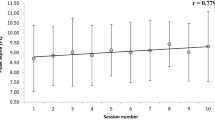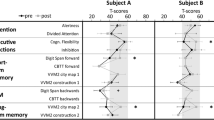Abstract
One year after a left posterior and thalamic stroke, a 52-year-old male participant was treated with 14 weeks of theta reduction neurofeedback training. Imaging studies revealed left temporal, parietal, occipital, and bilateral thalamic infarctions along the distribution of the posterior cerebral artery. Neuropsychological testing demonstrated severe verbal memory, naming, visual tracking, and fine motor deficits. Additionally, alexia without agraphia was present. A pretraining quantitative electroencephalograph (QEEG) found alpha attenuation, lack of alpha reactivity to eye opening, and excessive theta activity from the left posterior head region. Neurofeedback training to inhibit 4–8 Hz theta activity was conducted for 42 sessions from left hemisphere sites. Over the course of the training, significant reductions in theta amplitude occurred from the training sites as assessed from the postsession baseline periods. Posttraining, a relative normalization of the QEEG was observed from the left posterior head region.
Similar content being viewed by others

REFERENCES
Ayers, M. E. (1999). Assessing and treating open head trauma, coma, and stroke using real-time digital EEG neurofeedback. In J. Evans & A. Abarbanel (Eds.), Introduction to quantitative EEG and neurofeedback (pp. 203-222). New York: Academic Press.
Cantor, D. S. (1999). An overview of quantitative EEG and its applications to neurofeedback. In J. Evans & A. Abarbanel (Eds.), Introduction to quantitative EEG and neurofeedback (pp. 3-27). New York: Academic Press.
Cummings, L., Dane, A., Rhodes, J., Lynch, P., & Hughes, A. M. (2000). Diurnal variation in the quantitative EEG in healthy adult volunteers. British Journal of Clinical Pharmacology, 50, 21-26.
Damasio, A. R., & Damasio, H. (1983). The anatomic basis of pure alexia. Neurology, 33, 1573-1583.
Derogatis, L. R. (1993). Brief Symptom Inventory (BSI): Administration, scoring, and procedures manual (3rd ed.). Minneapolis, MN: National Computer Systems, Inc.
Hoffman, D., Stockdale, S., Hicks, L., & Schwaninger, J. (1995). Diagnosis and treatment of head injury. Journal of Neurotherapy, 1(1), 14-21.
Hughes, J. R., & John, E. R. (1999). Conventional and quantitative electroencephalography in psychiatry. Journal of Neuropsychiatry and Clinical Neurosciences, 11, 190-208.
Jorgensen, H., Nakayama, H., Raaschou, H., Vive-Larsen, J., Stoier, M., & Olsen, T. (1995). Outcome and time course of recovery in stroke. Part II: Time course of recovery, the Copenhagen stroke study. Archives of Physical Medicine and Rehabilitation Archives of Physical Medicine and Rehabilitation, 76, 406-412.
Lezak, M. D. (1983). Neuropsychological assessment (2nd ed.). New York: Oxford University Press.
Niedermeyer, E. (1998). Cerebrovascular disorders and EEG. In E. Niedermeyer & F. L. Da Silva (Eds.), Electroencephalography (4th ed., pp. 215-234). New York: Lippincott Williams & Williams.
Othmer, S., Othmer, S. F., & Kaiser, D. A. (1999). EEG biofeedback: An emerging model for its global efficacy. In J. Evans & A. Abarbanel (Eds.), Introduction to quantitative EEG and neurofeedback (pp. 243-310). New York: Academic Press.
Putman, J. A. (2001). EEG biofeedback on a female patient stroke patient with depression: a case study. Journal of Neurotherapy, 5(3), 27-38.
Reitan, R., & Wolfson, D. (1993). The Halstead-Reitan neuropsychological test battery (2nd ed.). Tucscon, AZ: Neuropsychology Press.
Rozelle, G., & Budzynski, T. (1995). Neurotherapy for stroke rehabilitation: A single case study. Biofeedback and Self-Regulation, 20(3), 211-228.
Schuell, H. (1965). Administrative manual for the Minnesota test for differential diagnosis of aphasia. Minneapolis, MN: University of Minnesota Press.
Sharbrough, F. W. (1998). Nonspecific abnormal EEG patterns. In E. Niedermeyer & F. H. Lopes Da Silva (Eds.), Electroencephalography (4th ed., pp. 215-234). New York: Lippincott Williams & Williams.
Thornton, K. (2000). Improvement/rehabilitation of memory functioning with neurotherapy/QEEG biofeedback. Journal of Head Trauma Rehabilitation, 15(6), 1285-1296.
Wechsler, D. (1981). WAIS-R manual. New York: The Psychological Corporation.
Wechsler, D. (1987). Wechsler Memory Scale—Revised manual. San Antonio, TX: The Psychological Corporation.
Author information
Authors and Affiliations
Corresponding author
Rights and permissions
About this article
Cite this article
Bearden, T.S., Cassisi, J.E. & Pineda, M. Neurofeedback Training for a Patient with Thalamic and Cortical Infarctions. Appl Psychophysiol Biofeedback 28, 241–253 (2003). https://doi.org/10.1023/A:1024689315563
Issue Date:
DOI: https://doi.org/10.1023/A:1024689315563



